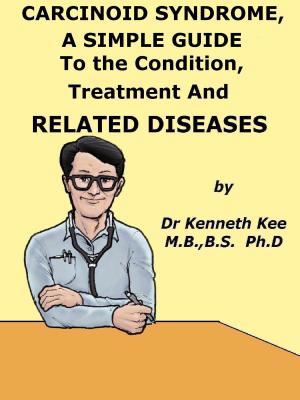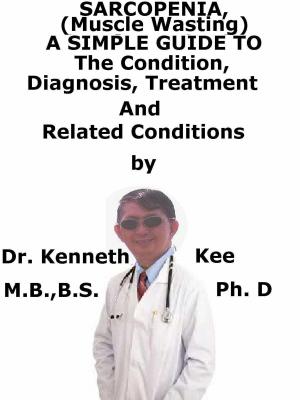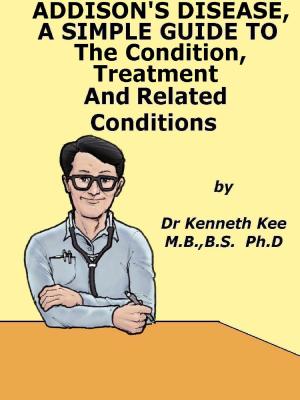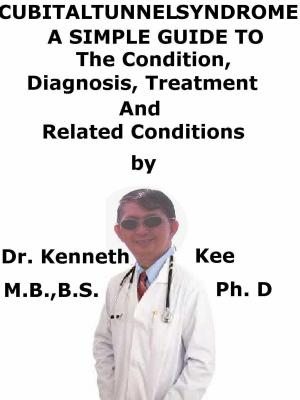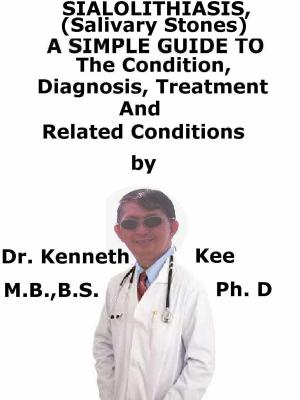Pompholyx, (Dyshidrotic Ezcema) A Simple Guide To The Condition, Diagnosis, Treatment And Related Conditions
Nonfiction, Health & Well Being, Medical, Specialties, Dermatology, Health, Ailments & Diseases, Skin| Author: | Kenneth Kee | ISBN: | 9781370697458 |
| Publisher: | Kenneth Kee | Publication: | December 3, 2017 |
| Imprint: | Smashwords Edition | Language: | English |
| Author: | Kenneth Kee |
| ISBN: | 9781370697458 |
| Publisher: | Kenneth Kee |
| Publication: | December 3, 2017 |
| Imprint: | Smashwords Edition |
| Language: | English |
This book describes Pompholyx (Dyshidrotic Eczema), Diagnosis and Treatment and Related Diseases
Pompholyx (Dyshidrotic eczema) is a disorder in which small blisters form on the hands and feet.
Pompholyx derives from the Greek word for bubble.
Small, very itchy blisters on the palms and along the sides of the fingers could indicate dyshidrotic eczema.
These blisters will occur intermittently over time because there is no cure.
But the patient can treat them with medicine, moisturizers, and good hygiene.
They might begin to taper off once the patient reaches middle age.
And if the patient has a mild case, it could ultimately go away on its own.
Causes
The exact cause is not known.
The disorder appears to occur during certain times of the year.
Doctors suggested that the cause entailed a complex immunological procedure which required complement, myeloperoxidase (a lysosomal protein stored in azurophilic granules of the neutrophil) and T cells.
There are a number of often recognized irritating factors such as emotional stress, allergic contact dermatitis and allergens such as chromate, neomycin or nickel.
There is a link with atopy and tinea pedis but both pompholyx and tinea pedis tendency to occur with sweaty feet is not proven.
A genetic form has been found.
HIV infection and treatment of HIV-infected patients with antiretroviral therapy (ART) have both been related, together with intravenous immunoglobulin therapy
Several things can trigger dyshidrotic eczema such as:
1.Stress
2.Contact with metals like nickel, cobalt, or chromium salts on the job or from things like wearing costume jewelry
3.Sweaty or wet hands and feet
4.Warm, humid weather
5.HIV infection
6.Certain treatments for a weak immune system (immunoglobulin)
This disorder is not contagious (direct contact infection)
Symptoms
The disorder may be acute, chronic or recurrent.
80% affect the hands, 12% the feet and 8% both areas:
The involved areas are the center of the palms or soles.
It is normally symmetrical.
After several hours of itching or burning in the hands, feet, or both, the blister forms
Tiny vesicles, about 1 or 2 mm in diameter, form first along the lateral aspects of the fingers and then on the palms or soles.
Palms and soles may be red and wet with sweat.
Later in the course there may be broken vesicles with inflamed bases, possibly followed by peeling or rings of scale or lichenification.
Vesicles may erupt in waves.
The vesicles normally last for three or four weeks and then disappear spontaneously
These blisters can be very itchy
Diagnosis:
The doctor may be able to diagnose this disorder by examining the skin.
A skin biopsy may be required to exclude other causes
Treatment
The disorder is self-limiting but, because it can be very itchy, symptomatic treatment may be required.
In practice, many patients need a combination of treatments.
Burow's solution (10% aluminum acetate in a 1:40 dilution), is a drying lotion
The fluid from large blisters can be drained under aseptic conditions.
Antibiotics are only needed if secondary infection happens.
Strong topical steroids may be needed to control itching, and cold compresses
Second-line treatment can be the administration of oral steroids.
Long-wave PUVA can be used
Serious cases may be treated with methotrexate, azathioprine, mycophenolate mofetil or cyclosporine
If nickel sensitivity has been reported, a nickel chelator such as sulfiram (Antabuse) may be useful
Aluminum chloride 20% and iontophoresis may work if hyper-hidrosis causes problems.
Botulinum A toxin has been very useful in some patients.
The patient should keep the skin moist
An antihistamine or cold compresses may stop the itch.
TABLE OF CONTENT
Introduction
Chapter 1 Pompholyx (Dyshidrotic Eczema)
Chapter 2 Causes
Chapter 3 Symptoms
Chapter 4 Diagnosis
Chapter 5 Treatment
Chapter 6 Prognosis
Chapter 7 Eczema
Chapter 8 Contact Dermatitis
Epilogue
This book describes Pompholyx (Dyshidrotic Eczema), Diagnosis and Treatment and Related Diseases
Pompholyx (Dyshidrotic eczema) is a disorder in which small blisters form on the hands and feet.
Pompholyx derives from the Greek word for bubble.
Small, very itchy blisters on the palms and along the sides of the fingers could indicate dyshidrotic eczema.
These blisters will occur intermittently over time because there is no cure.
But the patient can treat them with medicine, moisturizers, and good hygiene.
They might begin to taper off once the patient reaches middle age.
And if the patient has a mild case, it could ultimately go away on its own.
Causes
The exact cause is not known.
The disorder appears to occur during certain times of the year.
Doctors suggested that the cause entailed a complex immunological procedure which required complement, myeloperoxidase (a lysosomal protein stored in azurophilic granules of the neutrophil) and T cells.
There are a number of often recognized irritating factors such as emotional stress, allergic contact dermatitis and allergens such as chromate, neomycin or nickel.
There is a link with atopy and tinea pedis but both pompholyx and tinea pedis tendency to occur with sweaty feet is not proven.
A genetic form has been found.
HIV infection and treatment of HIV-infected patients with antiretroviral therapy (ART) have both been related, together with intravenous immunoglobulin therapy
Several things can trigger dyshidrotic eczema such as:
1.Stress
2.Contact with metals like nickel, cobalt, or chromium salts on the job or from things like wearing costume jewelry
3.Sweaty or wet hands and feet
4.Warm, humid weather
5.HIV infection
6.Certain treatments for a weak immune system (immunoglobulin)
This disorder is not contagious (direct contact infection)
Symptoms
The disorder may be acute, chronic or recurrent.
80% affect the hands, 12% the feet and 8% both areas:
The involved areas are the center of the palms or soles.
It is normally symmetrical.
After several hours of itching or burning in the hands, feet, or both, the blister forms
Tiny vesicles, about 1 or 2 mm in diameter, form first along the lateral aspects of the fingers and then on the palms or soles.
Palms and soles may be red and wet with sweat.
Later in the course there may be broken vesicles with inflamed bases, possibly followed by peeling or rings of scale or lichenification.
Vesicles may erupt in waves.
The vesicles normally last for three or four weeks and then disappear spontaneously
These blisters can be very itchy
Diagnosis:
The doctor may be able to diagnose this disorder by examining the skin.
A skin biopsy may be required to exclude other causes
Treatment
The disorder is self-limiting but, because it can be very itchy, symptomatic treatment may be required.
In practice, many patients need a combination of treatments.
Burow's solution (10% aluminum acetate in a 1:40 dilution), is a drying lotion
The fluid from large blisters can be drained under aseptic conditions.
Antibiotics are only needed if secondary infection happens.
Strong topical steroids may be needed to control itching, and cold compresses
Second-line treatment can be the administration of oral steroids.
Long-wave PUVA can be used
Serious cases may be treated with methotrexate, azathioprine, mycophenolate mofetil or cyclosporine
If nickel sensitivity has been reported, a nickel chelator such as sulfiram (Antabuse) may be useful
Aluminum chloride 20% and iontophoresis may work if hyper-hidrosis causes problems.
Botulinum A toxin has been very useful in some patients.
The patient should keep the skin moist
An antihistamine or cold compresses may stop the itch.
TABLE OF CONTENT
Introduction
Chapter 1 Pompholyx (Dyshidrotic Eczema)
Chapter 2 Causes
Chapter 3 Symptoms
Chapter 4 Diagnosis
Chapter 5 Treatment
Chapter 6 Prognosis
Chapter 7 Eczema
Chapter 8 Contact Dermatitis
Epilogue


